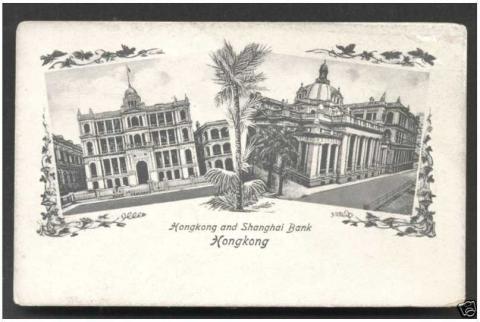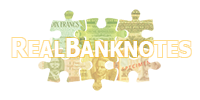Feng Shui and the Lions

Most collectors have a few Hong Kong notes in their collections, and at least one of them features the Hong Kong and Shanghai Bank building on the reverse of the note. The bank even began featuring the famous bronze lions on the front of their notes beginning in 1993. Let's take a look at the three historical buildings that comprised the Hong Kong and Shanghai Banking Corporation in Hong Kong. The HKSBC was formed in 1865, shortly after the Colony was established in 1841. It rapidly outgrew the warren of cubicles that comprised it's initial space, a leased warehouse. A new building was commissioned and completed in 1886. This huge edifice was a clearly Victorian Era monument, and it's workers sweltered in high collars and eyeshades under punkahs and electric fans, as they performed banking duties and administered branches in 7 countries and colonies of Asia and the numerous Treaty Ports of China. This $10 note from 1941 shows the old bank building, this is the less-imposing North face fronting on the main street along the harbor.

This photo shows the original building, the South face fronts along the harbor, and the North face along the harbor drive.

By the mid-1930's, however, stability in China and throughout Asia and made the HKSBC the largest banking firm in Asia. In 1934, the old Victorian building was torn down, and a new building erected, opening in October 1935. The photo below shows the new building in 1936, as it fronted on the open square built on reclaimed harbor land. When it was built, it was the first air-conditioned, or climate-controlled, building in the Far East.

The staid HKSBC directors, however, did not get around to changing the banks' currency designs until 1959. Talk about conservative Scots bankers ! The familiar design was last issued on April 2nd, 1959, and was the last note to feature the old bank. On May 2nd, 1959, a new, smaller, note was issued, with a slightly redesigned face but a new view of the new (1935 new!) building on the reverse. As you can see from the new note, the buildings on the Peak behind the bank were somewhat hastily engraved, but this is the first time the famous bronze lions, named Stephen and Stitt after two bank Directors, have been featured on the currency of the Colony. You can just make them out across Statue Square to both sides of the North entrance. In 1992 one of the lions, either Stephen or Stitt, were placed on the front of the currency, and they take turns today as the face of the HKSBC banknote. Together, they sit facing each other on the back of the note.


And so the HKSBC soldiered on, through WWII, when the building was used by the Japanese Army to govern the captured Colony, through 1949 when China fell to the Communists, and the next 30 years as Hong Kong built and cemented its' status as the financial powerhouse of the Far East.
By the 1970's, even this building had been outgrown, and a new design was commissioned. This time, however, the HKSBC directors were planning for 1998, and foresaw the end of British rule in Hong Kong. The building was warranted to be designed so that it could literally be dismantled and moved, presumably to Singapore, in the event of a hostile Chinese government takeover of the Colony. As it were, by 1998 the Chinese were no longer the enemies of the capitalist running dogs of Far East banking, and this has not yet been necessary, although the end of the 50 years of Autonomy for Hong Kong are fast approaching. It may still be necessary to move the building yet! The new building, completed in 1985, is composed of parts built in Scotland and other parts of Europe, brought to Hong Kong, and assembled on site. It features amazing internal architecture, which is the subject of a daily guided tour, and lovely quasi-public spaces and offices. Every square foot of the building was designed for, and approved by, Feng Shui experts so that the demons and spirits of the Far East, numerous as they are, will not enter the building or haunt the public square. Stephen and Stitt, for example, were deliberately sited for maximum Feng Shui effect. The lions, Stephen and Stitt, were re-installed at the North entrance, where they form a delightful tourist attraction in their own right. In 1992, the lions were placed together on the back of the note, along with a picture of the new building. Once again, the directors of the bank were late in commemorating such august changes by re-designing the banknotes, this time it was only 7 years, and not 24 years.

Today, the HKSBC building is a noted landmark on the Hong Kong waterfront. It never was, nor intended to be, the largest building fronting the harbor, but it certainly has been the home of the most important financial business ever to open in the Colony, let alone the entire Far East. The photo below shows the building at night.






